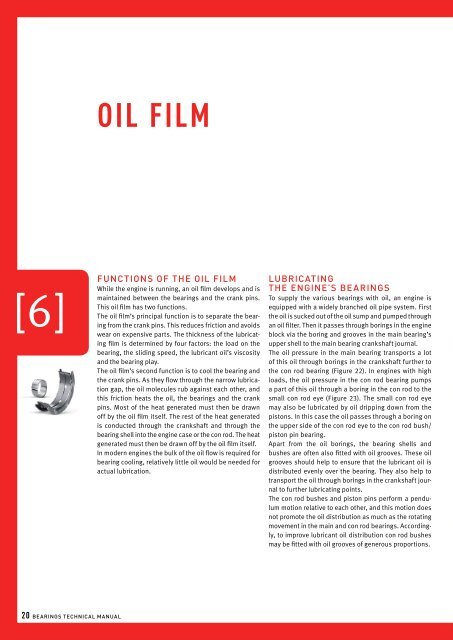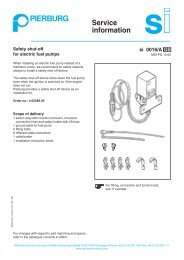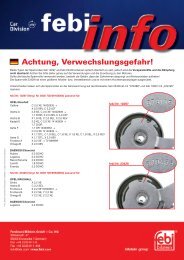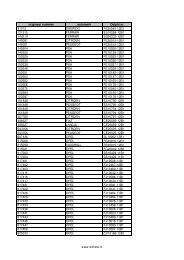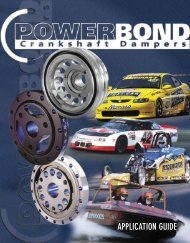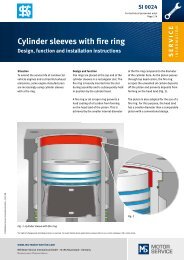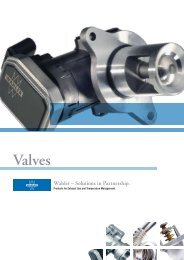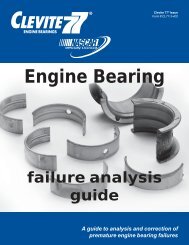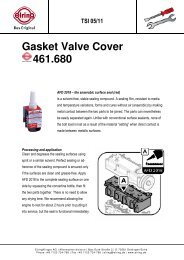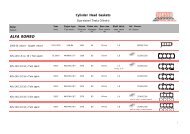EvEry bEaring you nEEd
EvEry bEaring you nEEd
EvEry bEaring you nEEd
Create successful ePaper yourself
Turn your PDF publications into a flip-book with our unique Google optimized e-Paper software.
[fig.22]<br />
Crankshaft journal with oil pipes shown in broken lines. The oil pressure in the main bearings pumps the oil through<br />
these oil pipes to the con rod bearings.<br />
Oil film<br />
con rod bearing crank pin<br />
crank webs<br />
main bearing crank pin<br />
oil drills<br />
[6]<br />
Functions of the oil film<br />
While the engine is running, an oil film develops and is<br />
maintained between the bearings and the crank pins.<br />
This oil film has two functions.<br />
The oil film’s principal function is to separate the bearing<br />
from the crank pins. This reduces friction and avoids<br />
wear on expensive parts. The thickness of the lubricating<br />
film is determined by four factors: the load on the<br />
bearing, the sliding speed, the lubricant oil’s viscosity<br />
and the bearing play.<br />
The oil film’s second function is to cool the bearing and<br />
the crank pins. As they flow through the narrow lubrication<br />
gap, the oil molecules rub against each other, and<br />
this friction heats the oil, the bearings and the crank<br />
pins. Most of the heat generated must then be drawn<br />
off by the oil film itself. The rest of the heat generated<br />
is conducted through the crankshaft and through the<br />
bearing shell into the engine case or the con rod. The heat<br />
generated must then be drawn off by the oil film itself.<br />
In modern engines the bulk of the oil flow is required for<br />
bearing cooling, relatively little oil would be needed for<br />
actual lubrication.<br />
Lubricating<br />
the engine’s bearings<br />
To supply the various bearings with oil, an engine is<br />
equipped with a widely branched oil pipe system. First<br />
the oil is sucked out of the oil sump and pumped through<br />
an oil filter. Then it passes through borings in the engine<br />
block via the boring and grooves in the main bearing’s<br />
upper shell to the main bearing crankshaft journal.<br />
The oil pressure in the main bearing transports a lot<br />
of this oil through borings in the crankshaft further to<br />
the con rod bearing (Figure 22). In engines with high<br />
loads, the oil pressure in the con rod bearing pumps<br />
a part of this oil through a boring in the con rod to the<br />
small con rod eye (Figure 23). The small con rod eye<br />
may also be lubricated by oil dripping down from the<br />
pistons. In this case the oil passes through a boring on<br />
the upper side of the con rod eye to the con rod bush/<br />
piston pin bearing.<br />
Apart from the oil borings, the bearing shells and<br />
bushes are often also fitted with oil grooves. These oil<br />
grooves should help to ensure that the lubricant oil is<br />
distributed evenly over the bearing. They also help to<br />
transport the oil through borings in the crankshaft journal<br />
to further lubricating points.<br />
The con rod bushes and piston pins perform a pendulum<br />
motion relative to each other, and this motion does<br />
not promote the oil distribution as much as the rotating<br />
movement in the main and con rod bearings. Accordingly,<br />
to improve lubricant oil distribution con rod bushes<br />
may be fitted with oil grooves of generous proportions.<br />
[fig.23]<br />
This illustration shows the oil pipe in a con rod in a broken line. The oil pressure in the con rod bearing pumps the oil<br />
through this pipe to the piston pin bush in the small con rod eye.<br />
piston pin<br />
drilled oil way<br />
bearing oil hole<br />
crank pin<br />
20 Bearings Technical Manual<br />
21


